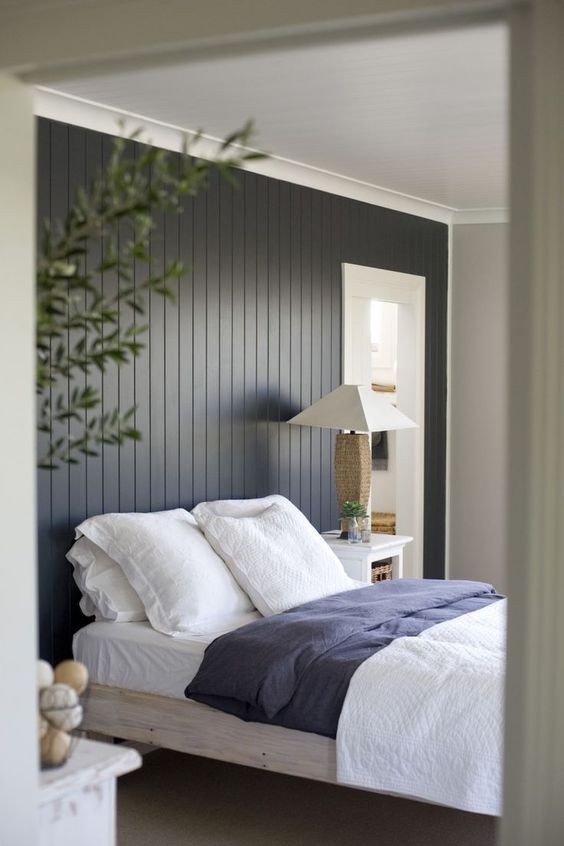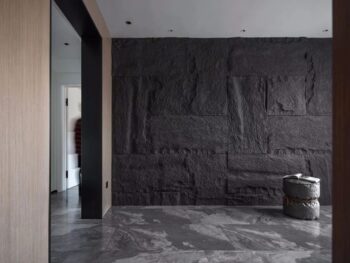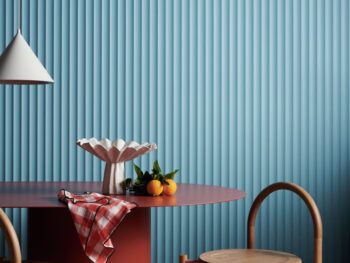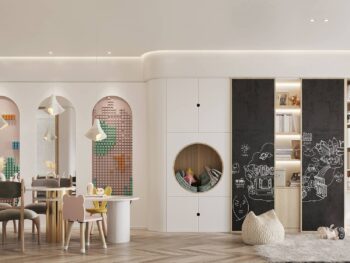
Choose MDF or WPC Wall Panels?
When furnishing an interior space, choosing the right wall cladding material is crucial to creating the desired ambiance and style. Among the many wallboard materials, MDF wallboard (medium density fiberboard) and WPC wallboard (wood-plastic composite wallboard) are two options that have attracted much attention. They each have unique features and benefits for different decorative needs and environments.
In this article, we will conduct a comprehensive comparison between MDF wall panels and WPC wall panels to help you better understand their differences so you can make informed decorating decisions.
Related Articles
VJ Wall Panel: A Decorative Way to Create Vertical Texture
PVC Wall Panel: Beautiful and Functional Interior Decoration
Comparison of PVC Wall Panel and VJ Panel
I. What is MDF?
MDF wall panel is an interior decoration material. It is a board made of medium density fiberboard (MDF) and is commonly used for wall covering and decoration. MDF is a synthetic material that is processed from wood fibers and adhesives through high temperature and pressure. During the manufacturing process, wood fibers are compressed into a board of uniform density, hence the name MDF.
MDF wall panels have a smooth and flat surface, and can be decorated by painting, laminating, skinning, etc., providing a wealth of design and style options. It can imitate the grain and texture of wood, and it can also present other decorative effects, such as stone, tile, etc.
MDF wall panels are widely used in interior decoration, and can be used for wall decoration in living rooms, bedrooms, restaurants, offices and other spaces. Because of its flat surface and easy processing, it can be cut, engraved and customized according to design needs. However, it is important to note that MDF siding is not suitable for use in wet environments, as moisture may cause it to swell and become damaged.
In short, MDF wall panels play an important role in interior decoration with their flat surface, rich decorative effects and plasticity, giving the space unique beauty and style.

II. What are the advantages and disadvantages of MDF?
Advantages
1. Smooth surface
MDF wall panels have a smooth surface and are suitable for various decoration methods such as painting, stickers, and spraying to achieve various appearance effects.
2. Easy to process
MDF wall panels are easy to cut, carve, drill and engrave, so a variety of complex designs and decorative effects can be achieved.
3. Strong stability
MDF wall panels are composed of fibers and adhesives, so they change less in size and shape than solid wood and are not susceptible to moisture, expansion or contraction.
4. Environmental protection
Because MDF is made by pressing wood fibers and glue, it does not require large amounts of solid wood, thus helping to reduce the need for natural trees. In addition, using MDF can also utilize wood processing by-products and reduce waste.
5. Uniform texture
The fibers of MDF wall panels are evenly distributed during processing, so their surface flatness and texture uniformity are high.
6. Affordable
Compared with solid wood wall panels, the manufacturing cost of MDF wall panels is relatively low, so it has the advantage of being economical.
7. Highly decorative
MDF wall panels can be decorated in various ways, such as spraying, printing, engraving, etc., making them suitable for different interior design styles.
8. Sound insulation performance
Due to the high density of MDF wall panels, they have a certain sound insulation effect and help reduce the transmission of indoor and outdoor sound.
9. Good coating effect
The surface of MDF wall panels is smooth and absorbs paint better, so it can achieve better painting results.
Disadvantages
1. Easily absorb moisture and swell
Due to its fibrous structure, MDF wall panels tend to absorb moisture and swell in high-humidity environments, which may cause deformation, cracking, or peeling.
2. Not resistant to moisture
Due to its fibrous structure, MDF wall panels can become damaged when exposed to moisture for extended periods of time, causing warping, rot, or mold growth.
3. Intolerant of heavy pressure
MDF wall panels are relatively soft and cannot withstand heavy pressure, and are prone to dents or scratches under pressure.
4. Not suitable for outdoor use
Due to its moisture-intolerant and easily damaged nature, MDF wall panels are not suitable for use in outdoor environments, especially if exposed to rain or sunlight.
5. Formaldehyde is released
Some cheap MDF wall panels may use adhesives that contain volatile organic compounds such as formaldehyde, which can cause indoor air quality issues. This is something to pay special attention to, especially on new installations.
6. Difficulty in edge processing
The edges of MDF wall panels tend to absorb water, so special care is required when performing edge treatments (such as painting, welting) to prevent the edges from absorbing moisture and swelling.
7. Not resistant to high temperatures
MDF wall panels cannot withstand high temperatures as their adhesives may be damaged, causing the material to deform or release harmful gases.
8. Environmental issues
Making MDF requires the use of glue and energy, some of which may contain harmful chemicals. Additionally, mass production of MDF may also have a negative impact on the environment.
III. What is WPC?
WPC wall panel is a kind of building material, whose full name is Wood-Plastic Composite Wall Panel. It is a product made of wood fiber and plastic composite and is usually used for indoor or outdoor wall decoration. This material combines the natural appearance of wood fiber with the weather resistance of plastic, and has many advantages, such as water resistance, anti-corrosion, wear resistance, easy cleaning, etc.
WPC wall panels are usually composed of wood powder, plastic particles and additives. Wood powder can be natural wood fibers such as sawdust, wood chips or bamboo powder, while plastic pellets are usually polyethylene (PE), polypropylene (PP) or polyvinyl chloride (PVC), etc. These components are combined through a heating, extrusion and forming process to form strong and durable wall panels.
The appearance of WPC wall panels can imitate the texture of wood while having the weather resistance and ease of maintenance of plastic. They can be used for indoor wall decoration, such as living rooms and bedrooms, and can also be used for outdoor walls, such as balconies, garden walls, etc. These wall panels are widely used in decoration and construction fields due to their properties such as fading resistance, mildew resistance, water resistance, and corrosion resistance.
In general, WPC wall panel is a wall decoration material that combines the characteristics of wood fiber and plastic. It has the appearance of natural wood and the durability of plastic, and is suitable for a variety of indoor and outdoor environments.

IV. What are the advantages and disadvantages of WPC wall panels?
Advantages
1. Natural look
WPC wall panels can imitate the texture and appearance of natural wood, giving indoor and outdoor spaces a natural and warm atmosphere, while avoiding the problem of unstable supply that may exist in solid wood materials.
2. Weather resistance
Due to its plastic content, WPC wall panels have excellent weather resistance, can resist the erosion of sunlight, rain, moisture and other natural environments, and are not easy to fade, deform or rot.
3.Water resistance
WPC wall panels are also stable in wet environments and will not absorb moisture or get damp, which makes them ideal for places with high humidity, such as bathrooms, kitchens, etc.
4. Anti-corrosion
Due to the addition of plastic components, WPC wallboards are not easily attacked by organisms such as fungi, bacteria, insects and ants, and have strong anti-corrosion properties and are more durable than some natural wood.
5. Easy to maintain
Compared with solid wood materials, the maintenance work of WPC wall panels is relatively simple. It usually only needs water and mild detergent to clean, without cumbersome maintenance.
6. Environmental protection
The use of wood fibers and recycled plastics in the manufacture of WPC siding helps reduce the need for natural wood and thus puts less pressure on forest resources.
7. Stability
The combination of wood-plastic composite materials makes WPC wall panels have relatively small thermal expansion and contraction when temperature and humidity change, so they have better dimensional stability.
8. Security
Many WPC wall panel surfaces have an anti-slip texture, which provides better safety in outdoor applications and prevents slip and fall accidents.
9. Design flexibility
WPC wall panels can be manufactured through molds, so they have some flexibility in design and can be produced in a variety of textures and shapes.
On the whole, WPC wall panels show many advantages in terms of appearance, weather resistance, environmental protection and easy maintenance, making them a popular choice for indoor and outdoor decoration.
Disadvantages
1. Higher cost
WPC siding is expensive to manufacture compared to traditional siding materials, which can lead to its relatively high price and may not be suitable for projects with limited budgets.
2. Thermal expansion and cold contraction
Due to the combination of wood fiber and plastic, WPC wall panels will expand and contract to a certain extent when the temperature changes, which may lead to dimensional changes, which need to be paid attention to during installation.
3. Limited color options
Compared with some other wall decoration materials, the color choices of WPC wall panels may be relatively limited, and may not be as diverse as some paints or wallpapers.
4. Poor plasticity
Compared with all-plastic materials, wood-plastic composites have relatively poor plasticity and are not suitable for making complex shapes or curves.
5. Environmental issues
Although WPC wall panels use some recyclable plastics, it still involves the use of plastics, and there are certain environmental issues, especially when dealing with waste materials.
6. Vulnerability
Although WPC wall panels have some weather resistance, they may be relatively fragile and prone to breakage when faced with strong impact or force.
7. Installation Difficulty
WPC siding may require more special tools and skill to install than traditional wood or dry-wall siding, especially if cutting or customizing is required.
8. Irrepairability
Once WPC siding is damaged, it is often difficult to repair and may require the entire siding to be replaced.
All things considered, although WPC wall panels have many advantages, there are also some potential disadvantages that need to be considered when choosing. For each project, its specific needs and constraints need to be considered comprehensively to determine whether to choose WPC wall panels as a suitable wall decoration material.

V. Comparison of the differences between MDF and WPC
MDF (Medium Density Fibreboard) and WPC (Wood Plastic Composite) are two common building and decorative materials that have some differences in composition, properties and applications. Here is a comparison of the main differences between MDF and WPC:
1. Ingredients
– MDF (Medium Density Fibreboard)
MDF is a board made of wood fibers and adhesives processed under high pressure and high temperature. Wood fibers are mixed, compressed and heat-pressed during the manufacturing process to form a uniform, high-density board.
– WPC (Wood Plastic Composite)
WPC is a composite material made by mixing wood fibers with plastic particles and additives. Generally, the wood fiber can be wood chips, wood powder or bamboo, etc., and the plastic component is usually polyethylene, polypropylene or polyvinyl chloride, etc.
2. Appearance and texture
– MDF
MDF is usually a uniform board without the texture of natural wood, but has a smooth surface and is suitable for surface treatments such as painting and veneering.
– WPC
WPC siding can mimic the look and grain of natural wood, so it has a more natural texture and is often used for trim that mimics the look of real wood.
3. Weather resistance and moisture properties
– MDF
MDF is sensitive to moisture and is prone to hygroscopic swelling, so it is not suitable for use in humid environments.
– WPC
Due to the addition of plastic components, WPC material has better water resistance and weather resistance, and is suitable for indoor and outdoor environments.
4. Application field
– MDF
MDF is commonly used in interior furniture, home decoration, wall decoration, partitions, interior decoration, etc.
– WPC
WPC materials are usually used for indoor and outdoor wall decoration, garden fences, outdoor furniture, balcony floors, floor slabs, etc.
5. Environmental protection
– MDF
MDF uses adhesives during the production process, which may contain volatile organic compounds such as formaldehyde. The environmental protection of some MDF boards requires special attention.
– WPC
WPC material is more environmentally friendly than some traditional wood and MDF because it reduces the need for natural wood, but still involves the use of plastic.
6. Properties and uses
– MDF
MDF usually has a smooth surface and is suitable for decoration such as painting, skinning, engraving, etc., but it may be brittle under strong impact.
– WPC
WPC wall panels have the appearance of natural wood but are more water and weather resistant than solid wood, making them suitable for wall decorations that require beauty and durability.
Taken together, there are differences between MDF and WPC in terms of composition, properties and applications. Which material to choose depends on the specific decorative needs and environment.
VI. Conclusion
To sum up, MDF wall panels and WPC wall panels, as interior decoration choices, each have a series of unique features and advantages, and are suitable for different decoration needs and environments. When making your decision, you should consider factors such as your personal preferences, project needs, and budget.
If you’re after a classic, functional finish, MDF wall panels are a solid choice. Its smooth surface and versatile decorative options make it an ideal substrate for painting, foiling and engraving. However, you should note that MDF can swell in humid environments and will also require additional protection against scratches and scuffs.
On the other hand, if you’re looking to incorporate more natural beauty and durability into your decor, WPC wall panels are a compelling choice. Its simulated wood grain appearance combined with the weather resistance of plastic gives you more design possibilities and is suitable for a variety of indoor and outdoor environments. Especially where resistance to moisture and climate change is required, WPC siding excels.
Ultimately, choosing between MDF siding or WPC siding will depend on your specific needs and preferences. Whether you want a classic utilitarian look or a more natural aesthetic, both wall panels give you a variety of options. Before making a decision, make sure to fully understand the characteristics of each type of wall panel so that you can create the desired effect for your interior.
Quick Quotation



